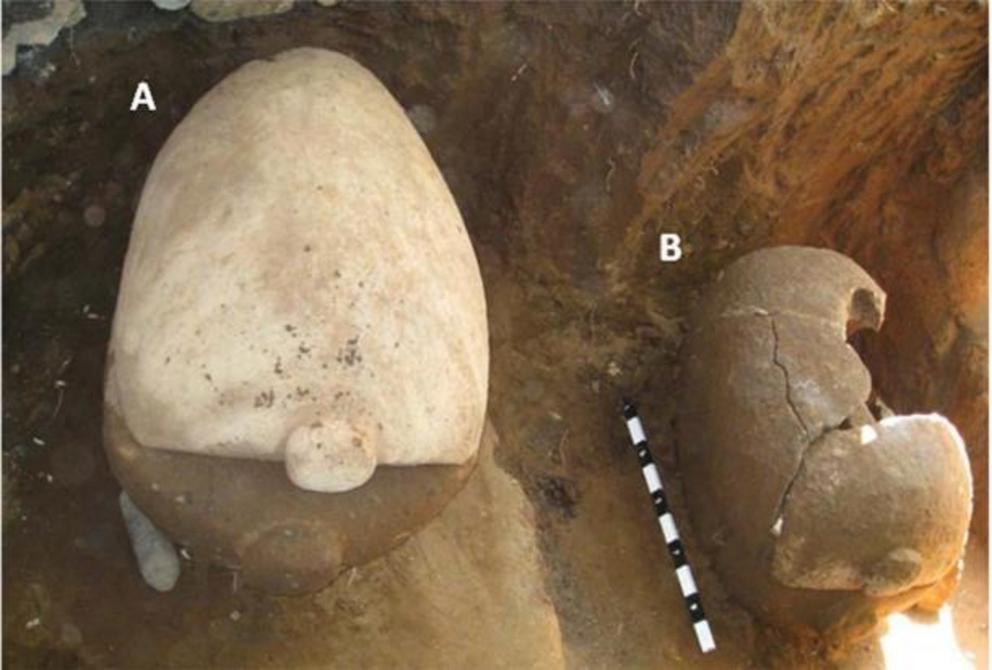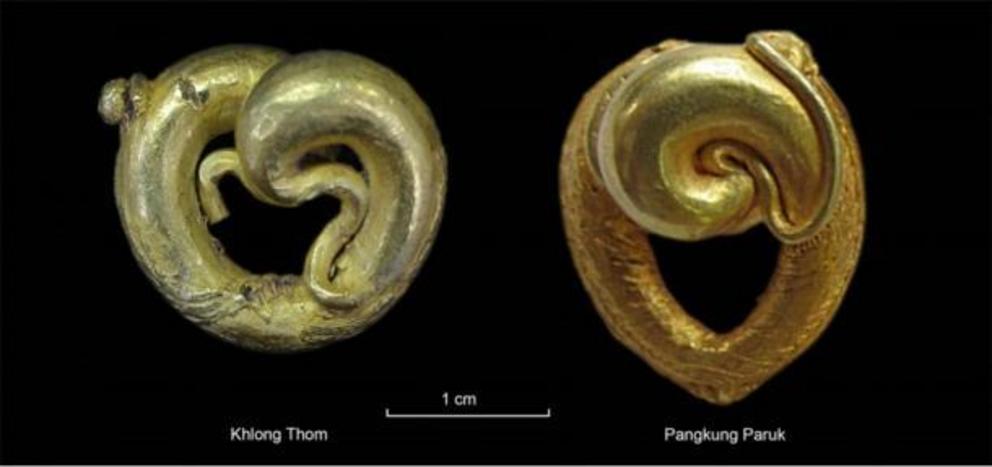Bali gold hoard reveals untold links with Roman Empire
Bali gold ornaments found at Pangkung Paruk.
Archaeologists excavating in Bali have presented the largest collection of Roman gold-glass beads ever discovered in early Southeast Asia, which proves the existence of an ancient trade route where the Bali gold was obtained from.
Pangkung Paruk is a village in Seririt sub-district, Buleleng Regency, Bali Province, Indonesia and according to a new paper published on Cambridge.org, following the discovery by the landowner in 2009 of an oval-shaped stone sarcophagus, excavations were conducted in 2009 and 2011 by the Bali Institute of Archaeology (BALAR), at its burial site.
 Excavation of sarcophagus A and B in 2009, where the Bali gold was found.
Excavation of sarcophagus A and B in 2009, where the Bali gold was found.
Now the site has yielded the largest collection of Roman gold-glass beads in early Southeast Asia found to date, and what’s more, a collection of elaborate gold ornaments and two Han Chinese bronze mirrors make this discovery “unprecedented” in Southeast Asia.
Bali’s Golden Grave Goods
The late prehistoric/ Iron Age open-air site of Pangkung Paruk is located 2km inland from the northern coast of central Bali, on a hilltop overlooking a bay in Buleleng Province. Analysis of these new finds and comparisons with other examples from across the Mekong Delta for example, those from Oc Eo in Vietnam, a major southern Vietnamese center of trade, and other sites on the Thai-Malay Peninsula, have provided insights into the early to mid 1st-millennium AD trans-Asiatic trade networks that once linked Southeast Asia to South Asia, with China and the ancient Roman world.
 Map showing the proximity of the Pangkung Paruk excavation site in Indonesia, where the Bali gold was found.
Map showing the proximity of the Pangkung Paruk excavation site in Indonesia, where the Bali gold was found.
From the late 1st millennium BC, Bali was linked via the Sunda Island chain maritime route to South Asia, the western Indian Ocean and via mainland Southeast Asia to China. This is all now evident in the results of excavations at the Pangkung Paruk site, which the scientists concerned have called “a rich and diverse assemblage.” The discovery includes four stone sarcophagus burials and imported burial goods, including hoards of shell and bronze artifacts, Roman gold-glass beads, two pairs of elaborately decorated solid gold ear pendants and two Chinese bronze mirrors.
A second sarcophagus was discovered containing a flexed inhumation and gold, glass, gold-glass, carnelian, shell and bronze artifacts matching those in the first sarcophagus. Also in the second sarcophagus, a bronze drum was also found placed with other artifacts over and around the individual’s skull and an “unenclosed, flexed inhumation” was also found next to sarcophagus B.
 Pangkung Paruk glass beads.
Pangkung Paruk glass beads.
Evidence Of Hitherto Unknown Trade Routes
In total, the Pangkung Paruk burials have yielded 43 gold-glass beads, which the researchers found to be of “Roman-era Egyptian” origin, representing the largest collection of such gold-glass beads from any pre-historic context in Southeast Asia.
Additionally, 19 gold-glass beads, with evidence of production where thin layers of gold foil was inserted between two layers of transparent glass, were excavated at Oc Eo, according to the paper. These were typically found at western Indian Ocean sites, such as Berenike on the Red Sea , in Nubia and the Persian Gulf.
 Comparison between Bali gold ear pendants (left) and Oc Eo gold ear pendants with the circles highlighting the similarity of the decorative schemes.
Comparison between Bali gold ear pendants (left) and Oc Eo gold ear pendants with the circles highlighting the similarity of the decorative schemes.
Nine beads were analyzed by Dr. James Lankton and Dr. Bernard Gratuze, using laser ablation inductively coupled plasma mass spectrometry (LA-ICP-MS), and their results were compared against a large database of prehistoric glass found in Asia. All nine gold-glass beads had been crafted from natron glass, which Pliny the Elder describes as being widely used for much of the first millennium BC and AD to sixth century.
But these particular gold-glass beads were made in Egypt and in the coastal Levant, during the first to fourth centuries AD. The authors say gold-glass beads formed an important part of the Roman glass trade in the mid 1st-century AD and that they were taken to southeast Indian ports and onwards to the Ganges Delta. From here they were sent eastwards to trading zones located along the Thai-Malay Peninsula.
 Comparison between gold ear pendants from Khlong Thom (another excavation site on Thai-Malay Peninsula) and Pangkung Paruk.
Comparison between gold ear pendants from Khlong Thom (another excavation site on Thai-Malay Peninsula) and Pangkung Paruk.
Mapping The Crumbs Of Ancient Bead Traders
As mother of the largest collection of Roman soda-natron gold-glass beads, Pangkung Paruk adds significant new information to scientists’ knowledge of the early first-millennium AD distribution of such beads across Africa and Asia. The Paruk gold-glass beads were produced in Egypt during the first to fourth centuries AD and match Roman glass excavated on the southern Indian subcontinent and along the Thai-Malay Peninsula, confirming the suspected ancient southern maritime trade route between the western Indian Ocean and Southeast Asia.
 Maps of the Indian Ocean, showing sites mentioned in the article; the inset shows Bali in detail where the Bali gold was found.
Maps of the Indian Ocean, showing sites mentioned in the article; the inset shows Bali in detail where the Bali gold was found.
Furthermore, the scientists’ comparative compositional study of gold excavated across Southeast Asia provides critical data regarding the origins of imported gold as it has compatible signatures with gold from central Vietnam and Laos, and it can be traced to the Sepon copper source in Laos.
Having now proven that the people of Paruk imported artifacts at Oc Eo and other sites in the Mekong Delta and on the Thai-Malay Peninsula, the researchers suggest that Bali and southern Vietnam may have also been connected along a north-south route passing through northwestern Borneo, as well as via the better understood route from the Thai-Malay Peninsula to Indonesia.

